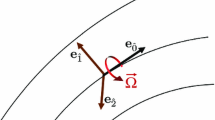Abstract
Lower-order terms in expansions of the equations of General Relativity in powers of v/c (post-Newtonian approximations) have long been a source of analogies with em theory. A classic textbook example is the steadily spinning sphere generating a constant dipole gravitomagnetic field, with its associated vector potential B* 0 =∇ × ζ (analog of the magnetic field B of a spinning charged sphere). In the nonsteady case there are associated gravitoelectric fields E* = − ζt − ∇φ* also, where φ* is the gravitational Coulomb potential. The case of a rigid sphere spun up from rest by an external (nongravitational) torque at t = 0 is enlightening, as it demonstrates the generation of B* and E* wave fields propagating outward with the velocity of light c: for large t, B* → B* 0. In a coordinate system for which the metric tensor is nearly equal to the Minkowski tensor, the three-vector potential ζ obeys an equation isomorphic to the electrodynamic equation, that is, □2ζ = −μ*j* with j* = −ρv, where ρ is the mass density, v the three-velocity, and μ* = 16πGc−2 = 3.7 × 10−26 mksu, G being the gravitational constant. Significantly, one can construct a gauge invariant four-vector potential F* = (ic−14φ*, ζ), obeying field equations isomorphic to Maxwell's in the Lorentz gauge Fα ,α = 0. The traveling transient dipole field exerts torques on matter in its path, setting up shear strains that may be measurable for very large momentum transfers, for example, between massive astronomical bodies. A rough calculation suggests that such strains are in principle observable.
Similar content being viewed by others
REFERENCES
Abramovici, A., Althouil, M. E., Drever, R.W. P., Gursal, Y., Kawamura, S., Raab, F. J., Shoemaker, D., Sievers, L., Spero, R. E., Thorne, K. S., Vogt, R. E., Weiss, R., Whitcomb, S. E., and Zucker, H. E. (1992). LIGO: The laser interferometer gravitational-wave observatory. Science 256, 325.
Adler, R. J. and Silbergleit, A. S. (1999). A general treatment of geodetic and lense-thirring effects on an orbiting gyroscope. In Proceedings of the Fourth Alexander Friedman International Seminar on Gravitation and Cosmology, pp. 102–115.
Adler, R. J. and Silbergleit, A. S. (2000). International Journal of Theoretical Physics 39, 291–316.
Braginsky, V. B., Caves, C. M., and Thorne, K. S. (1977). Laboratory experiments to test relativistic gravity, Physical Review D 15(6), 2047.
Einstein, A. (1921). The Meaning of Relativity, Princeton University Press, Princeton.
Everitt, C.W. F. (1988). The Stanford Relativity Gyroscope Experiment. In Near Zero: New Frontiers in Physics, Vol. VI 3(A), 587.
Everitt, C. W. F. (1992). The merits of space and cryogenic operation in the gravity probe B relativity gyroscope mission. In Advanced Series in Astrophysics and Cosmology, Ruffini, R. and Fang, L. Z., eds. Vol 7: Relativistic Gravitational Experiments in Space, 309.
Forward, R. L. (1961). Proceedings of IRE 49, 892.
Misner, C. W., Thorne, K. S., and Wheeler, J. A. (1997). Gravitation, Freeman, San Fransisco.
Stachel, J. (1980). Einstein and the rigidly rotating disk. In General Relativity and Gravitation, GRG Conference, Berne, p. 1.
Thorne, K. S. (1988). Gravitomagnetism, jets in quasars, and the Stanford gyroscope experiment. In Near Zero: New Frontiers in Physics, Vol. VI 2. p. 573.
Tolstoy, I. (1973). Wave Propagation, McGraw-Hill, New York.
Weinberg, S. (1972). Gravitation and Cosmology, Wiley, New York.
Author information
Authors and Affiliations
Rights and permissions
About this article
Cite this article
Tolstoy, I. Gravitomagnetic and Gravitoelectric Waves in General Relativity. International Journal of Theoretical Physics 40, 1021–1031 (2001). https://doi.org/10.1023/A:1004191225779
Issue Date:
DOI: https://doi.org/10.1023/A:1004191225779



